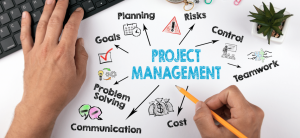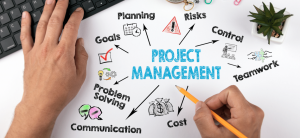Project Management: How to Build an Efficient Product Development Team? Source
Translated
-
 ZenTao ALM
ZenTao ALM -
 2022-12-21 10:00:00
2022-12-21 10:00:00 -
 1094
1094
The success of a product requires not only good planning but also efficient execution. Since the execution of product-related tasks is ultimately the responsibility of the product development team, building an efficient product development team is one of the preconditions for the success of a product.
Building a product development team involves many parts, such as organizational structure, division of responsibilities, project management, and teamwork. This paper will explain how to build an efficient product development team from the perspective of project management.
I. Background
The significance of project management:
- Improve the planning of research and development work
- Define the division of functions within the R&D team
- Ensure the quality of the product from all aspects
- Improve the efficiency of research and development work
The following will explain the differences in project management methods in different development stages from project procedures, project tools, change management and delay management.
II. Project Procedures
1. Product Planning
1) Stage Overview
Product planning is the first step in the product development process to define the iteration direction of the product.
2) Preconditions
Requirements gathering and analysis should be completed before product planning.
3) Participants and Responsibilities
4)Deliverable
Planning scheme of product.
5)Sign of the End of the Stage
Complete the planning scheme of the product and pass the review of the product planning review meeting.
2. Project Launch
1)Stage Overview
Project launch is a part of team building and project planning in product research and development.
2)Preconditions
Product planning has been completed.
3)Participants and Responsibilities
4)Deliverable
Project master plan, project sub-plan, project member list.
5)Sign of the End of the Stage
Hold the project launch meeting.
3. Prototyping
1)Stage Overview
Prototyping is a process in which product managers transform requirements into product prototypes.
2)Preconditions
Product planning has been completed.
3)Participants and Responsibilities
4)Deliverable
The product prototype.
5)Sign of the End of the Stage
The prototype can pass the requirements review.
4. UI Design
1)Stage Overview
UI design is a part in which UI designers complete the visual interface design, including layout and color matching.
2)Preconditions
The prototype design has been completed, and the prototype has passed the requirements review.
3)Participants and Responsibilities
4)Deliverable
UI effect picture
5)Sign of the End of the Stage
Complete the UI effect picture design, and the UI effect picture can pass the review meeting.
5. Product Development
1)Stage Overview
Product development refers to a process in which web front-end and back-end development engineers develop code to achieve product functions, pages, and logic.
2)Preconditions
The prototype and UI design has completed and passed the corresponding review meeting.
3)Participants and Responsibilities
4)Deliverable
The debug version.
5)Sign of the End of the Stage
All functions are debugged and deployed to the test environment.
6. Product Test
1)Stage Overview
A product test is a part of testing the function and performance of a product.
2)Preconditions
The product has been debugged and deployed to the test environment.
3)Participants and Responsibilities
4)Deliverable
Version to be deployed
5)Sign of the End of the Stage
The test cases are reviewed by the Test Case Review and all functional tests are completed based on the test cases.
7. Product Acceptance
1)Stage Overview
Product acceptance is a step in product development in which the product manager and UI designer check the conformity between the final product effect and the design scheme.
2)Preconditions
The product test has been completed.
3)Participants and Responsibilities
4)Deliverable
Version to be deployed.
5)Sign of the End of the Stage
Pass product acceptance.
8. Deploy to Live
1)Stage Overview
Deploy to Live is a milestone for the project team. The product code is switched from the test environment to the formal production environment. Ordinary users can directly access the product by opening the online web page link.
2)Preconditions
Product testing and acceptance have been completed.
3)Participants and Responsibilities
4)Deliverable
Official version.
5)Sign of the End of the Stage
The product launches and runs normally.
9. Project Summary
1)Stage Overview
A project summary is a link in which project team members comprehensively summarize the good or bad places in the project process.
2)Preconditions
The product has been launched.
3)Participants and Responsibilities
The participants in the project summary stage are all project members, and each project member summarizes the whole project and their responsible parts.
4)Deliverable
Summary of the project.
5)Sign of the End of the Stage
Hold the project summary meeting, and make the project summary minutes.
10. Product Launch
1)Stage Overview
Product launch is a part in which the product manager notifies the company and customers of product release.
2)Preconditions
The product has been launched.
3)Participants and Responsibilities
4)Deliverable
Product release instructions.
5)Sign of the End of the Stage
Successful product launch.
III. Project Tools
1. Requirements Management
Internal and external requirements and demand pool management are done through a self-developed demand feedback system.
Customers, marketing, sales, service, and cooperative departments can log in to the demand feedback system to submit requirements. Product managers can log in to the system to process and feedback requirements and put valuable requirements into the demand pool to provide reference information for subsequent product planning.
2. R&D Collaboration
Carry out requirements &bug delivery within the R&D team through a self-developed R&D collaboration system.
Product managers can define versions, record, and track requirements in the R&D collaboration system.
All team members can record bugs in the R&D collaboration system.
Test engineers can track bugs in the R&D collaboration system.
Front-end and back-end development engineers can mark requirements &bug to handle in the R&D collaboration system.
3. Process Assets
Record and retain project process assets by sharing documents online.
4. Project Follow-up
Follow up the project through daily, weekly, and monthly reports.
IV. Change Management
Requirement change is one of the important reasons leading to the out of control of the project, so it is necessary to regulate the requirement change process in project management strictly.
If it is necessary to change the requirement, the person who wants to change shall apply Ding Ding. The change shall be allowed only after being notified and agreed upon by the relevant product development and test leaders, and the reason for the change shall be recorded. Changes are required to be formally recorded, and verbal notification or chat transcripts are not allowed.
V. Delay Management
The delay in the product launch is a common phenomenon in project management. However, the delay will lead to decreased customer satisfaction and the morale of project team members, so it should be avoided as much as possible.
In order to avoid project delay, the followings should be done:
- Follow-up in time in the project process.
- Avoid related delay risks in advance.
- Adjust as soon as possible when some part has been delayed.
VI. Summary
Good project management can improve a team's efficiency, but each part needs to be managed according to the actual situation. Besides the above methodology, the communication and management of personnel are more important in project management.
Support
- Book a Demo
- Tech Forum
- GitHub
- SourceForge
About Us
- Company
- Privacy Policy
- Term of Use
- Blogs
- Partners
Contact Us
- Leave a Message
- Email Us: [email protected]

















